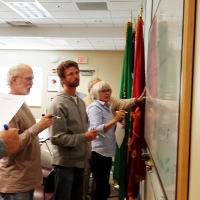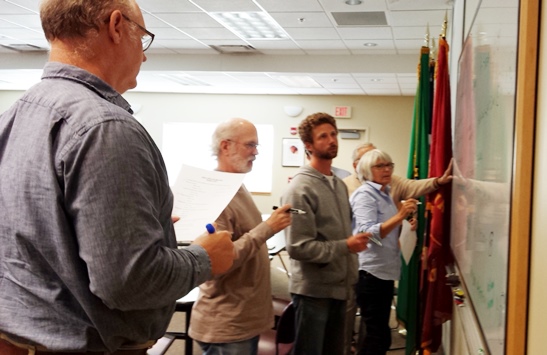— by Margie Doyle —
The Eastsound Planning Review Committee (EPRC) agreed on five top work plan priorities at its monthly meeting on Oct. 5. They also encouraged the community to complete the Eastsound Vision Survey, and heard a report from County Council Chair Rick Hughes. In its preliminary review process, EPRC members discussed plans to add a retail facility to the marijuana grow operation in the Service/Light Industrial property on Mount Baker Road.
As part of the work in progress to update the County Comprehensive Plan (orcasissues.com/orcas-islanders-turn-comp-plan-vision/), the County will also be updating the goals and policies to the Eastsound Subarea Plan. An update was submitted by the EPRC to the county in December 2015 with several items left unaddressed: orcasissues.com/county-council-approves-eastsound-subarea-plan/
This comp plan update will drive the future of Eastsound over the next 20 years, EPRC Chair Jeff Otis said in a written message.
The EPRC volunteer county advisors stated their priorities in its 2018 Workplan and assigned lead roles within the EPRC to “make sure EPRC stays on track and sets timelines” for dealing with the priorities:
- Agree to final plan/proposal on A-street dead-end solution, to be led by EPRC members Paul Kamin and Margaret Payne, with Bob Maynard on the team.
- Complete EPRC recommendations for updates to the Eastsound subarea plan goals and policies, led by Otis with Dan Vekved, Jonnie Welch and Jonatan Aldort on the team.
- Make recommendations for Service/Light Industrial designations, including the North Beach/Mt. Baker roads intersection; led by Vekved and Otis, with Kamin and Aldort on the team
- Designate public areas for open space, playgrounds, bathrooms, led by Aldort with Vekved, Payne and Welch on the team.
- Prepare a parking plan, led by Kamin and Welch with Payne and Maynard on the team
The secondary priorities were: prepare a lighting plan; prepare a streetscape plan for improvements by neighborhood; discuss Crescent Beach roads; review and comment on Housing Plan; and analyze Eastsound Land Use.
Marijuana grow operation expands to retail
The EPRC reviewed a permit from Tusco, to install a single-wide modular building on its site off Mt. Baker Road for the retail sale of cannabis (marijuana). There was some discussion of state law requiring “separation” between growing marijuana and selling it as retail. However, Councilman Hughes said that the county planning department had “made an initial determination that this is allowed because it allows Island Hoppin’ Brewery in the same Service/Light Industrial zone to “make beer in the back and sell it in the front.” Hughes added that in the past, “EPRC has pushed this concept through council and it’s a new addition.”
Kamin noted that the issue had been addressed by putting the retail operation in a different name from the production company.
EPRC members then questioned the property line setbacks and parking accommodations on the revised site plan for the grow/sell business.
County Council Report:
County Council Chair Rick Hughes reported to the EPRC on recent county developments including:
Fuel storage:
Hughes relayed the Hearing Examiner’s Oct. 2 decision regarding the denied conditional use permit (CUP) to install a 30,000 gallon propane tank and distribution center on a one-acre lot in the Seaview neighborhood.
Hughes advised that the EPRC look during the comp plan update at bulk fuel storage and try to find a place within Eastsound, or within the boundaries of service/light industrial (SLI) zoning. “Since Eastsound is our main commercial hub, it makes sense that EPRC make a recommendation and give feedback where bulk fuel storage could be put. We need to have a serious discussion about where to have fuel storage in Eastsound.”
Hughes said, “The county from the get-go did offer up a county parcel behind Sea Island Gravel, with improvements from developer for a bulk propane storage facility.” Bulk fuel storage is also allowed in Rural general use zones, or rural industrial zones. However, Hughes pointed out the logistics of unloading fuel from a barge at Obstruction Point and then delivering it to a distribution center more than halfway towards the other side of the island.
EPRC member Jonatan Aldort asked about the (empty) fuel storage tank at the County Public Works yard off Mount Baker Road near Seaview Street. Hughes replied that the county fuel tank does not require a permit “because it’s a secondary use for emergency management.” He clarified that the tank has storage capacity for 12,000 gallons of diesel and gasoline each, and that the fuel is not for commercial sale except in an emergency. “We may need to do screening, and appropriate fire suppression… there is a different set of safety measures because [the fuel is] not pressurized or liquid-cooled.
“If the community is not happy with that, I need to know. I never got any feedback until the propane tank issue came up,” Hughes said. In response to a question from EPRC member Bob Maynard about the need for the public works fuel storage, Hughes said “The county felt there was not sufficient back-up fuel available for county vehicles and other government entities” in the case of an emergency.
County Council Meet on Orcas
Hughes said the County Council and staff are meeting on Orcas on Tuesday, Oct. 31. In the afternoon, there will be a ribbon-cutting ceremony at the Park and Ride above Orcas Landing.
Hughes also spoke of the great Orcas attendance at the county Comprehensive Plan Vision meeting held on Oct. 3 “The County appreciates the amazing personal involvement of so many in the community; anything we can do to improve the process we want to hear it.”
Orcas Road project and other Public Works projects
The county is in final negotiations with property owners along the affected Orcas Road modifications, and hopes to begin work in early 2018 from McNally Road to Nordstrom Lanes, said Hughes. The plan involves evening out corners, and improving the banking and sight lines, and making improvements on McNally.
The Prune Alley modifications in process are “probably the two projects we’ll focus on,” Hughes said. The county now engages more “in-house consulting,” and concentrates on one project at a time.
Regarding a trail network in the Deer Harbor area, there needs to be plans for its design, and how to pay for it, Hughes said. One idea would be for the county to approve a Local Improvement District (LID) for payment by that defined area.
“We’re trying to maintain the infrastructure that we have, with work on docks and water facilities. With ballot measures pending on schools and a public hospital district, what is the appetite for continued taxation? We’re operating at a good efficiency level and we want to know from the community what you want.”
Kamin thanked Hughes for his work, saying that EPRC had asked him to present two items to the Council the previous month, and both had been acted upon:
1) the proliferation of A-frame signs in Eastsound. The county will send a code enforcement officer to Eastsound once a month in the summer to enforce the prohibition of signs except in three designated areas.
2) the request for view easement enforcement. The Council instructed the Prosecuting Attorney’s office to move forward and enforce the easements that have been in place for 30 years.
Eastsound Vision Survey
The County and the Eastsound Planning and Review Committee (EPRC) are attempting to reach out to as many people as possible in order to obtain a wide range of comments. EPRC Chair Jeff Otis wrote: “One way to express your thoughts about the future of Eastsound is to take the survey found at https://eastsoundvision.com/. The survey team and the EPRC recognize your time is precious and hope that you will see value in dedicating the time necessary to complete the survey. The results of the survey will be provided to the County to inform their work on the Comprehensive Plan.”
Toby Cooper, one of the survey authors, criticized the statistical validity of the survey, saying, “In a statistically valid survey the sample should not be selected voluntarily. Voluntary responses open the door to a lot of questions.
“The outreach is good, but by definition, the survey is haphazard and so fails the [statistical validity] test. How many millennials, part timers, or visitors are filling out the survey? If it doesn’t get enough [responses], it opens the door to more recruiting responses, which fails to meet the standard.
Cooper commented on the complexity and length of the survey, saying “Partial responses only compound the statistical problems in that you don’t have everybody responding to the same questions.”
He added, “The survey is one part of our recommendations, an effort to engage as many people as possible. It should not, I hope it won’t, be the only thing that’s looked at.”
Councilman Hughes said of the survey,”We never looked at this as a statistically accurate part of a survey of community attitudes, but as another way to hear from people, to reach the most people possible. I’m not going to use it as a statistically projected piece of data; it’s a wonderful tool for Eastsound people to be reached that a lot of hardworking people have put together.”
EPRC member Margaret Payne added that there will be demographic information on the survey to distinguish responders.
The survey may be found at https://eastsoundvision.com/
**If you are reading theOrcasonian for free, thank your fellow islanders. If you would like to support theOrcasonian CLICK HERE to set your modestly-priced, voluntary subscription. Otherwise, no worries; we’re happy to share with you.**










Correct me if I’m wrong, statistical mavens but I don’t believe Toby Cooper is correct in criticizing the Eastsound Vision survey in terms of its statistical validity. Although the survey may suffer from self-selection bias, that alone does not invalidate the results of the survey. Self-selection bias is common in many survey situations, and can be handled by weighting adjustments, among other techniques. To simpky assert bias without analyzing the dataset Margaret Payne references is a leap too far for me.
I would ask another one of our Eastsound Vision survey participants, Matthew Gilbert, to weigh in on Toby’s criticisms, since Matthew was the individual advising survey participants on elimination of survey bias, among others. Survey bias was discussed copiously in multiple meetings, hence I respectfully disagree with Toby. My brief education in psychometrics supports my opinion that the survey was created to eliminate as much bias as possible.
Paula Treneer
co-founder, Idun Partners, a financial education services provider
Is it too late to take the survey?
The survey is open until November 5th. Go to eastsoundvision.com
The survey, is just one peice of the puzzle, but an important one. So climb on board with your thoughts!!